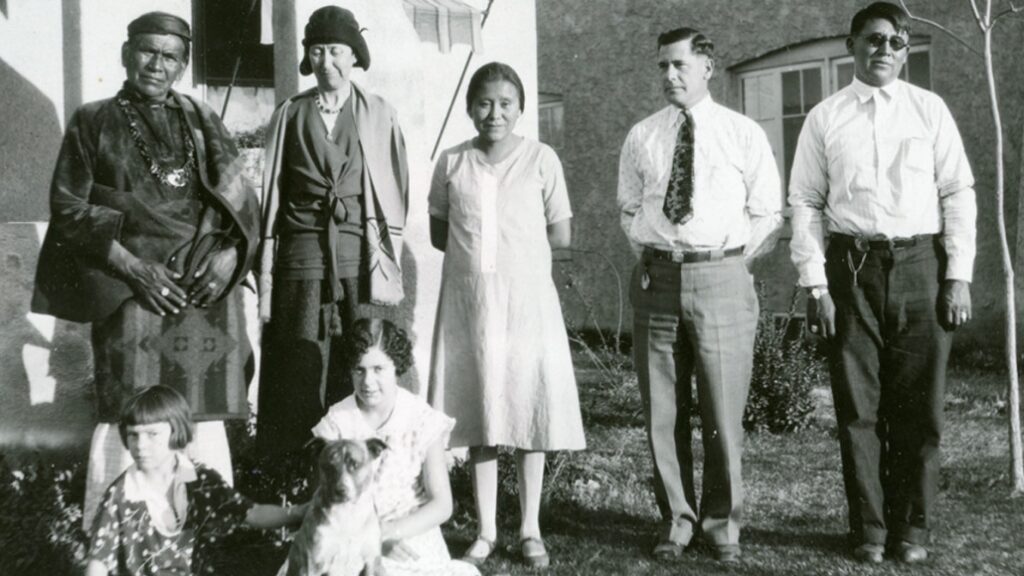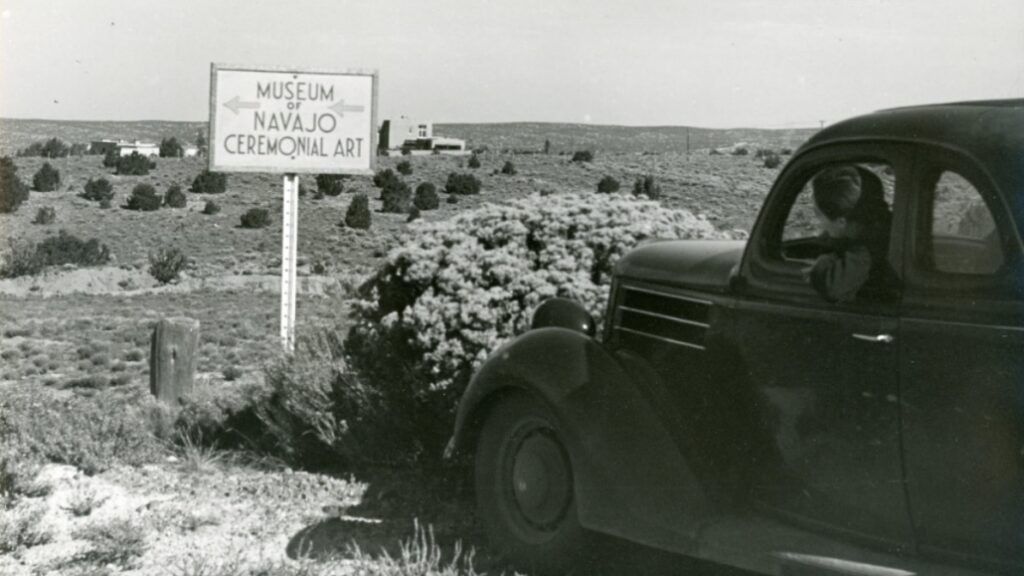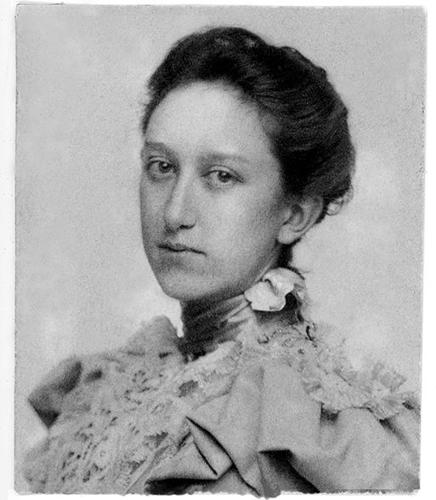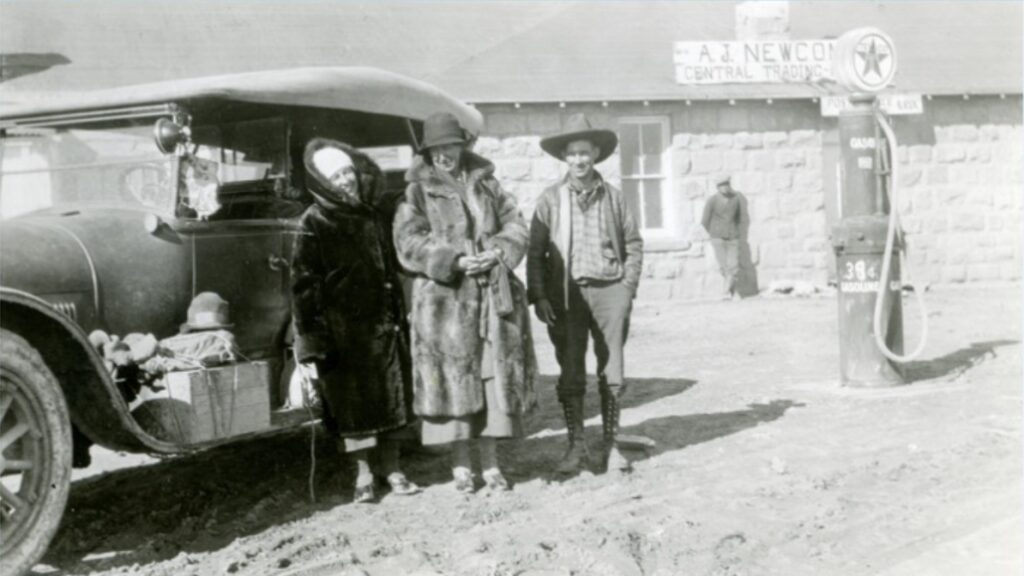Portrait of Mary Cabot Wheelwright
Photo Credit: Courtesy of Wheelwright Museum of the American Indian.
Mary Cabot Wheelwright
1878 - 1958
Santa Fe County
Daughter of a wealthy Boston family, she became an admirer, collector, and promoter of Native American art and a student and staunch supporter of indigenous cultures and traditions. Her extensive collection is now housed in the Wheelwright Museum of the American Indian, named in her honor.
Mary Cabot Wheelwright was born into the privileged society of Boston, Massachusetts. The only child of Andrew Cunningham Wheelwright and Sarah Perkins Cabot Wheelwright, she led a sheltered existence within the confines of permissible behavior for young ladies. Educational opportunities would have revolved around governesses, tutors, and schools operated by women in “reduced circumstances.” Although she did not possess a formal education, she considered herself an avid reader and was curious about a wide variety of subjects.
Wheelwright traveled with her parents to destinations in the United States as well as popular venues throughout Europe, Africa, and the Middle East. Her love of travel and interest in the cultures she observed would continue throughout her lifetime. Her father’s love of sailing and her mother’s love of music are clearly evident in Wheelwright’s life. She continued the tradition of spending the summer on Mount Desert Island, Maine, initially maintaining the family home Otherside in Northeast Harbor, and later The White Hen on Sutton Island.
Wheelwright’s initial experience with the Southwest occurred while traveling with her parents to California, and in 1914 she traveled with friends to the Grand Canyon. Her father’s death in 1908 and her mother’s death in 1917 left Wheelwright with a modest fortune and the freedom to cultivate her own interests.
Wheelwright took her first extended visit to New Mexico shortly after her mother’s death. While staying at the San Gabriel Dude Ranch in Alcalde, New Mexico, Wheelwright traveled to the Navajo Reservation with ranch owner Carole Stanley Pfaffle. Commenting on this initial visit in her memoirs Wheelwright wrote, “I seemed to get near to something I had always wanted, a more simple type of civilization, more adventuresome and more exciting than the safety of Boston.” This positive experience served as a catalyst for Wheelwright to explore and learn more about the cultures of Native Americans.
Sometime around 1921, Wheelwright met trading post owners Arthur and Frances Newcomb, who had moved after their marriage in 1914 to the Nava Trading Post, midway between Gallup and Shiprock New Mexico. The post’s name was changed to the Newcomb Trading Post several years later. The Newcombs developed and maintained good relationships with the Navajo families who regularly traded at the post. The most important friendship was with the highly respected and extremely knowledgeable Navajo ceremonial singer and weaver Hastiin Klah. Hastiin Klah taught the Newcombs about Navajo culture and explained their spiritual beliefs. Wheelwright was introduced to Hastiin Klah by the Newcombs. This introduction led Wheelwright to learn about the spirituality of the Navajo people. Her collaboration with Hastiin Klah became the primary focus of her life. The knowledge shared with her by Hastiin Klah and other ceremonial singers became the basis of a collection focused on Navajo ceremonialism.
Wheelwright purchased a home in Alcalde called Los Luceros, which she used as her base during her semi-annual visits to New Mexico and the Navajo Reservation. Following her initial meeting with Hastiin Klah and the Newcombs, she became a passionate supporter of the Navajo people. She worked with several traders, especially Cozy McSparron, to improve the quality of Navajo textiles, including encouraging a return to the use of vegetal dyes as well as finding better quality aniline dyes for textiles. She funded several awards at the Gallup Inter-tribal Ceremonial.
In 1927, Wheelwright offered to underwrite the costs to the newly organized Laboratory of Anthropology for a building devoted to her collection. She had her friend William Penhallow Henderson design a stylized hogan to house her acquisitions. The design was seen as too modern and did not conform with the Pueblo Revival Style building designed by John Gaw Meem. The content of Wheelwright’s collection was viewed as unscientific by many members of the Laboratory’s governing board. After years of conflict, in 1932 it was evident that Wheelwright could not erect the facility she envisioned, and she withdrew her offer.
Wheelwright’s friend Amelia Elizabeth White donated land adjacent to the Laboratory, and the House of Navajo Religion was erected in 1937. Although Hastiin Klah died before the museum was completed, a House Blessing Ceremony was held in November 1937 with members of Hastiin Klah’s extended family in attendance. A year later, the museum’s interior was completed and the museum was officially open to the public. While the Laboratory of Anthropology’s opening had been front page news in The New Mexican, the opening of the House of Navajo Religion was relegated to the society page.
The museum’s name changed to more adequately reflect its collection in 1939. The Museum of Navajo Ceremonial Art became the source for materials on Navajo spirituality. Wheelwright continued to collect information, and published a series of books and pamphlets. Wheelwright expanded her interests to include other indigenous religious beliefs and traveled to Japan, China, Sri Lanka, India, and New Zealand.
Wheelwright was an active and devoted member of the Eastern Association on Indian Affairs, now the American Association on Indian Affairs, as well as the New Mexico and Massachusetts affiliated associations. Wheelwright chaired several committees, served as an elected officer of the Massachusetts affiliate, and was also a director for the national association. She was actively involved in the Indian Arts Fund and the Spanish Colonial Arts Society in Santa Fe, and maintained an interest in several organizations in Massachusetts and Maine. She donated a collection of baskets made by local Native American tribes to the Abbe Museum in Bar Harbor, Maine. Collections in the Museum of Fine Arts, Boston, Historic New England (formerly the Society for the Preservation of New England Antiquities), the Museum of Spanish Colonial Art, the School for Advanced Research, and the Arizona State Museum were all recipients of Wheelwright’s generosity.
Wheelwright died on her beloved Sutton Island on July 29, 1958. She left a legacy of respect for indigenous cultures that continues in the museum that now bears her name.
Sources:
Amsden, Charles Avery. Navaho Weaving: Its Technic and History. Dover, 1991.
Babcock, Barbara & Nancy J. Daughters of the Desert: Women Anthropologists and the Native American Southwest 1880-1980. University of New Mexico, 1984.
Briggs, L. Vernon. History and Genealogy of the Cabot Family, Vols I & II. Boston:Goodspeed & Co. (1927) 2001.
Cabot, Sarah Perkins. Reminiscences. Unpublished memoir from Massachusetts Historical Society.
Ford, Amy, rev. Leatrice Armstrong and Willow Powers. Wheelwright Museum Docent Guidebook. Wheelwright Museum Archives.
Howe, Helen. The Gentle Americans:Biography of a Breed. New York:Harper & Rowe, 1965.
Lynes, Barbara Buhler and Ann Paden, eds. Maria Chabot-Georgia O’Keefe Correspondence. 1941-1949, Albuquerque:University of New Mexico, 2003.
Newcomb, Franc, Hosteen Klah: Navaho Medicine Man And Sand Painter. Norman, OK: University of Oklahoma, 1964.
Niederman, Sharon. A Quilt Of Words. Boulder, CO:Johnson Books, 1988.
Parezo, Nancy J., ed. Hidden Scholars: Women Anthropologists And The Native American Southwest. Albuquerque:University of New Mexico, 1993.
Sze, Corrine. History Of The Los Luceros Ranch: Rio Arriba County, New Mexico. Santa Fe:Research Services of Santa Fe, 2000.
Wheelwright, Mary Cabot. Journey Towards Understanding. Unpublished manuscript, Wheelwright Museum archives
Henry Ransom Center, University of Texas, Austin
Seeley Mudd Library, Princeton University, Princeton, New Jersey
Wheelwright Museum of the American Indian, Santa Fe, New Mexico
Directions:
Mary Cabot Wheelwright
Santa Fe County
Artist | Cultural preservationist | Philanthropist |
Statehood (1912 - present) | Territorial Period (1848 - 1912) |
North Central










